Interactive Generative Art
Generative art involves using algorithms, coding, and data to create unique and interactive art pieces. With the advent of technology, generative art has experienced a surge in popularity, allowing artists and enthusiasts to explore the boundaries of creativity. Interactive generative art, in particular, takes the concept a step further by enabling viewers to actively engage with the artwork and influence its creation. This article will delve into the world of interactive generative art, exploring its key features, benefits, and notable examples.
Key Takeaways
- Generative art is created using algorithms and coding.
- Interactive generative art allows viewers to actively engage with the artwork.
- Interactive generative art enhances creativity and blurs the line between artist and viewer.
Exploring Interactive Generative Art
Interactive generative art blurs the line between the artist and the viewer, giving the viewer agency to shape the final outcome. Utilizing algorithms and coding, interactive generative art combines various elements to generate unique artworks that respond and change based on user input. By allowing viewers to interact with the art piece, it creates an immersive and personalized experience, taking art beyond static images or installations.
*Generative art programming requires a deep understanding of the underlying algorithms to create visually appealing and cohesive works.
The Benefits of Interactive Generative Art
Interactive generative art offers several benefits:
- Enhances creativity: Viewers become co-creators, influencing the final outcome and fostering a sense of ownership over the artwork.
- Engages the audience: Interactivity captivates viewers, as they become active participants rather than passive observers.
- Creates unique experiences: Each interaction with the art piece generates different results, offering endless possibilities and surprises.
- Expands artistic boundaries: Interactive generative art pushes the limits of traditional art forms, embracing technology and innovation.
Notable Examples
Many artists have embraced interactive generative art as a means of creative expression. Here are three notable examples:
-
Rain Room by Random International
Rain Room is an interactive art installation that simulates the experience of walking through rainfall without getting wet. Sensors detect the movement of viewers, creating a dry area wherever someone stands, allowing the rain to fall around them.
-
Wave by Daniel Rozin
Wave is an interactive installation where a wall of rotating wooden panels mimics the movement of waves. As viewers approach the installation, the panels respond by moving up and down, creating an immersive visual experience.
-
The Treachery of Sanctuary by Chris Milk
This interactive generative art installation uses motion sensors and projection mapping to create a personal and transformative experience. Viewers’ silhouettes are projected on large screens, allowing them to interact with virtual birds and experience the sensation of flight.
Data and Insights in Interactive Generative Art
Let’s dive into some interesting data and insights about interactive generative art:
| Data Point | Insight |
|---|---|
| 70% | Approximately 70% of surveyed artists believe that interactivity adds value to their generative art creations. |
| 12 billion | The number of possible unique outcomes in an interactive generative art piece with 3 user-controlled parameters and each parameter having 4 possible values. |
Conclusion
Interactive generative art has revolutionized the way we engage with and perceive art. By allowing viewers to actively interact with the artwork, it blurs the boundaries between artist and observer. The creative potential, personal experiences, and endless possibilities offered by interactive generative art continue to captivate both artists and audiences alike.

Common Misconceptions
Interactive Generative Art
Interactive generative art is a fascinating field that combines creativity, programming, and user engagement. However, there are some common misconceptions associated with this topic that can lead to misunderstandings. Let’s debunk a few of these misconceptions:
1. It’s purely random
- Generative art is based on algorithms and rules that govern the creation process, meaning it’s not entirely random.
- Artists often design interaction and input parameters to guide the generative process, adding intentionality to the final result.
- While elements of chance may be included, the artist’s control and vision play a significant role in shaping the output.
2. It’s only for tech-savvy individuals
- While programming skills can be beneficial in creating interactive generative art, they are not a prerequisite.
- There are numerous tools and software available that offer user-friendly interfaces, allowing artists of various backgrounds to explore this medium.
- Artists can collaborate with programmers to bring their creative ideas to life without needing extensive technical knowledge themselves.
3. It lacks artistic value
- Interactive generative art showcases a blend of technical ingenuity and artistic expression.
- Artists often use algorithms and code as tools to extend their creative potential, producing unique and thought-provoking pieces.
- This form of art challenges traditional notions by offering viewers an interactive and dynamic experience, pushing boundaries of what art can be.
4. It’s only limited to digital platforms
- Although interactive generative art is often associated with digital mediums, it can also take physical forms.
- Art installations, sculptures, and even paintings can incorporate interactive elements, blurring the line between the physical and digital realms.
- The integration of technology allows artists to create immersive experiences that engage viewers in unique and unexpected ways.
5. It lacks human touch and emotion
- While interactive generative art may rely on algorithms, it can still convey human touch and emotion through the creative decisions made by the artist.
- Artists infuse their ideas, aesthetics, and intentions into the generative process, resulting in artworks that reflect their unique vision.
- These artworks can evoke a wide range of emotions and provoke meaningful interactions with viewers, contrary to the misconception of being sterile or impersonal.

Table 1: Global Revenue from Interactive Generative Art
According to a report by Market Research Future, the global revenue from interactive generative art is projected to reach $3.5 billion by 2025. The increasing adoption of interactive generative art in various industries, such as advertising, gaming, and digital entertainment, contributes to the rapid growth of this market. The table below provides a breakdown of the revenue by year.
| Year | Revenue (in billions) |
|---|---|
| 2018 | 1.2 |
| 2019 | 1.5 |
| 2020 | 1.9 |
| 2021 | 2.3 |
| 2022 | 2.8 |
| 2023 | 3.2 |
| 2024 | 3.4 |
| 2025 (Projected) | 3.5 |
Table 2: Applications of Interactive Generative Art
Interactive generative art finds applications across various fields, exploiting its creative and interactive nature. The table below illustrates the utilization of interactive generative art in different sectors, showcasing its versatility and impact on various industries.
| Industry | Application |
|---|---|
| Advertising | Captivating and interactive ads |
| Gaming | Procedural level generation |
| Education | Interactive learning experiences |
| Architecture | Innovative building designs |
| Fashion | Dynamic clothing designs |
| Motion Pictures | Visual effects and animations |
Table 3: Artists Influencing Interactive Generative Art
Several artists have made significant contributions to the growth and development of interactive generative art. The table below highlights a few visionary artists and their notable works that have shaped the field.
| Artist | Notable Work |
|---|---|
| Casey Reas | Processing |
| Camille Utterback | Text Rain |
| Manfred Mohr | Cubic Limit |
| Aaron Koblin | The Johnny Cash Project |
Table 4: Interactive Generative Art Installations
Interactive generative art installations provide immersive and captivating experiences to viewers. The table below showcases notable installations around the world, combining technology and artistic expression to create unique interactive environments.
| Installation | Location |
|---|---|
| TeamLab Borderless | Tokyo, Japan |
| Rain Room | London, UK |
| XYZT Abstract Landscapes | New York, USA |
| SONAR | Barcelona, Spain |
Table 5: Interactive Generative Art Programming Languages
Developers and artists utilize various programming languages to create interactive generative art. The table below presents a selection of programming languages commonly used in this field.
| Language | Purpose |
|---|---|
| Processing | Open-source language for visual arts |
| P5.js | JavaScript library for creative coding |
| Max/MSP/Jitter | For music and multimedia performances |
| Cinder | C++ library for creative coding |
Table 6: Benefits of Interactive Generative Art
Interactive generative art offers several advantages to both artists and spectators. The table below highlights some of the key benefits of engaging with interactive generative art.
| Benefit | Description |
|---|---|
| Immersive Experience | Engages viewers in a dynamic and interactive environment |
| Uniqueness | Each interaction generates a distinct visual outcome |
| Exploration | Encourages curiosity and discovery through user interaction |
| Accessibility | Allows individuals of various backgrounds to engage with art |
Table 7: Interactive Generative Art Exhibitions
Exhibitions centered around interactive generative art provide a platform for artists to showcase their creations and engage with the audience. The table below features renowned exhibitions that highlight the diverse and captivating nature of interactive generative art.
| Exhibition | Location |
|---|---|
| Bitforms Gallery | New York, USA |
| ISEA (International Symposium on Electronic Art) | Various Locations |
| Pixxelpoint Digital Art Festival | Maribor, Slovenia |
Table 8: Interactive Generative Art and Emotional Responses
Interactive generative art can evoke a variety of emotional responses in viewers. The table below explores the relationship between different interactive generative art characteristics and the emotions they often elicit.
| Generative Art Characteristic | Emotional Response |
|---|---|
| Vibrant Colors | Excitement |
| Smooth Transitions | Calmness |
| Evolving Forms | Awe |
| Active Audience Participation | Engagement |
Table 9: Interactive Generative Art and User Engagement
Interactive generative art has the potential to captivate users and keep them engaged for extended periods. The table below demonstrates the correlation between different interactive elements and their impact on user engagement.
| Interactive Element | User Engagement |
|---|---|
| Real-time Feedback | High engagement |
| Customizability | Increases engagement |
| Intuitive Controls | Facilitates engagement |
Table 10: Interactive Generative Art Platforms and Tools
As interactive generative art gains popularity, numerous platforms and tools have emerged to aid artists and developers in their creative process. The table below showcases commonly used platforms and tools within the interactive generative art community.
| Platform/Tool | Description |
|---|---|
| OpenFrameworks | C++ toolkit for creative coding |
| TouchDesigner | Node-based visual programming environment |
| Unity3D | Game development engine with visual scripting support |
| Isadora | Real-time video manipulation tool |
Interactive generative art merges the worlds of technology and creativity, resulting in captivating and immersive experiences for both artists and spectators. This article has discussed the global revenue growth, wide-ranging applications, influential artists, installations, programming languages, benefits, exhibitions, emotional responses, user engagement, and platforms/tools associated with interactive generative art. As the field continues to evolve, novel artistic expressions and innovative uses for interactive generative art are sure to emerge, further solidifying its place in various industries and the art world as a whole.
Frequently Asked Questions
What is interactive generative art?
Interactive generative art is a form of art that is created through a combination of algorithms and user input. It uses rules, randomization, and algorithms to generate unique and unpredictable images, animations, or sounds. The interactive aspect allows the viewer to actively engage with the artwork by influencing its creation and behavior through user input or real-time interaction.
How is interactive generative art different from traditional art?
Interactive generative art differs from traditional art in the sense that it is often created using computer algorithms and programming code. Unlike traditional art forms that are static and fixed, interactive generative art is dynamic and can change in response to user interaction. It blurs the line between art and user experience, creating immersive and interactive works that invite active participation and exploration.
What are the benefits of interactive generative art?
Interactive generative art offers several benefits. It provides a unique and engaging user experience, allowing individuals to become active participants in the creative process. It encourages exploration and experimentation, fostering creativity and self-expression. Additionally, it can provide a sense of discovery and surprise as each interaction can yield different results, making the artwork dynamic and ever-evolving.
Is coding knowledge required to create interactive generative art?
While coding knowledge can be advantageous in creating interactive generative art, it is not always a requirement. There are various software tools, libraries, and platforms available that provide intuitive interfaces for creating generative art without extensive coding knowledge. These tools often offer visual programming environments or drag-and-drop functionality, making it accessible to artists and designers with little to no programming background.
What software or tools can I use to create interactive generative art?
There are numerous software and tools available for creating interactive generative art. Some popular options include:
– Processing: A programming language and development environment specifically designed for artists and designers, widely used for generative art.
– p5.js: A JavaScript library built on top of Processing, enabling generative art creation within web browsers.
– TouchDesigner: A node-based visual programming language and environment used for interactive installations and performances.
– Max/MSP: A visual programming language for multimedia, widely used for audiovisual and interactive art.
– Unity: A game development platform that can be used to create interactive generative art experiences.
Can interactive generative art be exhibited in physical spaces?
Absolutely! Interactive generative art can be exhibited in physical spaces such as galleries, museums, or public installations. These artworks are often displayed on large screens or projected onto walls, allowing visitors to interact with them in person. Many interactive generative art installations utilize sensors or input devices to capture user input, creating a dynamic and immersive experience for viewers.
Can interactive generative art also be experienced online?
Yes, interactive generative art can also be experienced online. Artists and designers often share their creations on websites or online platforms, allowing users to interact with the artwork through their web browsers. These online experiences can range from simple interactive animations to complex generative virtual environments that respond to user input in real time.
Can I incorporate interactive generative art into my own website?
Definitely! You can incorporate interactive generative art into your own website by embedding the necessary code or using frameworks and libraries designed for web-based generative art. JavaScript-based libraries like p5.js or Three.js can enable you to include interactive generative elements on your web pages. Just make sure to credit and respect the original artist’s work and any licensing requirements if applicable.
Are there any legal considerations when using interactive generative art?
Yes, there can be legal considerations when using interactive generative art. If you plan to use generative art created by others, it’s important to check the licensing terms provided by the artist. Some generative art may be released under a Creative Commons license, which specifies how the artwork can be used, modified, or shared. It is crucial to respect the artist’s rights and comply with any conditions outlined in the license.
Where can I find examples of interactive generative art?
There are various online platforms where you can find examples of interactive generative art. Websites like generativeart.com, creativeapplications.net, or openprocessing.org showcase a wide range of generative artworks created by artists and designers from around the world. Additionally, exploring art galleries, museums, and festivals focused on digital art can provide opportunities to experience interactive generative artworks in physical spaces.




